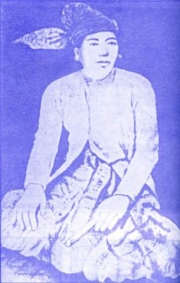Kanaung Mintha
| Kanaung ကနောင်မင်းသား |
|||||
|---|---|---|---|---|---|
 |
|||||
|
Crown Prince of Burma Prince of Kanaung |
|||||
| Reign | 18 February 1853 – 2 August 1866 | ||||
| Coronation | 11 June 1853 | ||||
| Predecessor | Pagan | ||||
| Successor | Thibaw | ||||
| Born |
31 January 1820 Amarapura |
||||
| Died | 2 August 1866 (aged 46) Mandalay |
||||
| Burial | Sandamuni Pagoda, Mandalay Hill | ||||
| Spouse | 18 wives | ||||
| Issue | 20 sons, 15 daughters | ||||
|
|||||
| House | Konbaung | ||||
| Father | Tharrawaddy | ||||
| Mother | Me Nu, Queen of South Palace | ||||
| Religion | Theravada Buddhism | ||||
| Full name | |
|---|---|
| Maung Kauk |
Kanaung Mintha (Burmese: ကနောင်မင်းသား; 31 January 1820 – 2 August 1866) was a son of King Tharrawaddy and younger brother of King Mindon of Burma. Towards the end of the Second Anglo-Burmese War, Kanaung and Mindon overthrew their half brother Pagan (1848–1853); Mindon ascended the throne and Kanaung became the Heir Apparent on 11 July 1853. He was the fiery "War Prince" and the peoples' idol. Kanaung attempted to modernize the country by sending scholars to Western countries and by founding an arms industry. However, his efforts were cut short when he was killed by his two nephews. Notwithstanding his short life, he is revered by Burmese nationals for his innovations in modernizing Burma.
King Mindon was dedicated to religion, but Kanaung was skillful in administration, serving as the leader (သမ္မတ, thamada) of the Hluttaw, the kingdom's administrative body. Under Kanaung's guidance, the following reforms were undertaken: centralization of the kingdom's internal administration, introduction of a salary system for the bureaucracy (to dampen the authority and income of bureaucrats), fixed judicial fees, comprehensive penal laws, reorganization of the financial system, removal of trade barriers including custom duties, reform of the thathameda taxes (to increase direct taxation), and modernization of the kingdom's army and introduction of new police forces.
Kanaung tried to rebuild the Burmese Army with modern weapons. He sent men to study in Western countries to establish an up-to-date arms industry. His efforts were well depicted in contemporary stories and poems. One story relates to his effort in testing depth charges in order to repulse British troops sailing up the Irrawaddy. Eventually, these testings were thwarted by the head of the Buddhist Sangha who protested against them by asserting their harmful effects on aquatic lives. Another story tells about his visits to the factories on cold early winter mornings while wrapping in a blanket. He was also known for his waywardness as depicted in a famous love song called Seinchu Kya-nyaung bawlè written by his wife, Princess Hlaing Hteik-hkaung Tin.
...
Wikipedia
